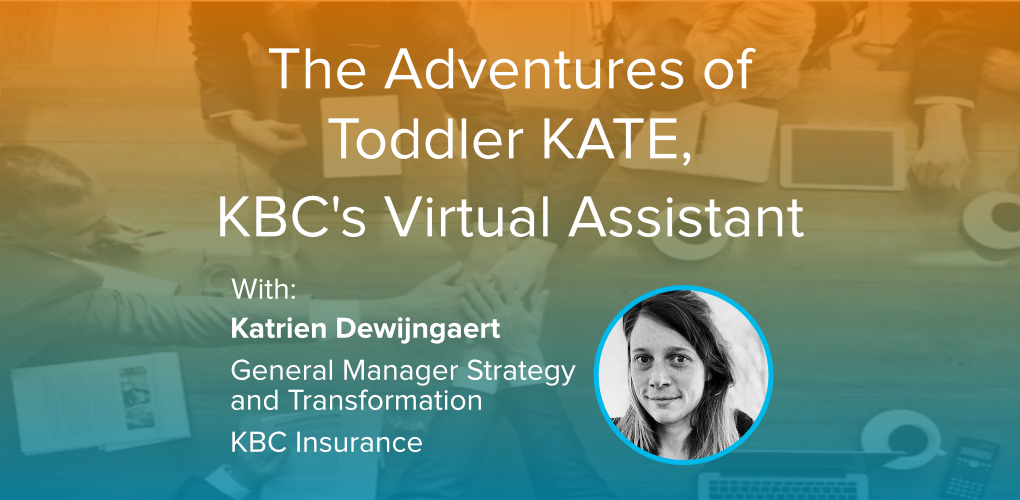
Insights & Opinions
The Adventures of Toddler KATE, KBC's Virtual Assistant
Tue, 08 Feb 2022


"Kate is more than a chatbot. You can say that it is the brain of a baby today. Still, the idea is that she becomes a beautiful young lady", said Karin Van Hoecke in 2020, back then, as General Manager Digital Transformation and Data at KBC Bank Belgium during The Banking Scene Afterwork.
More than 1 year later, I thought it was time for an evaluation. So we asked Katrien Dewijngaert, General Manager Strategy and Transformation at KBC Insurance, this time, to join us on February 3rd 2021.
Kate: at the centre of KBC's strategy
There exists a confusion that Kate is a chatbot. Kate is not just the digitisation of a chat flow. From everything I heard, Kate is already today, so much more.
Instead of switching from paper to digital, Kate triggers the organisation to rethink its business.
"Kate is all about helping our customers to make their life much easier, to save them time and money. That's why we are building Kate. We start with the why. When we develop products, when we develop or touch upon current processes within the insurance company, within the banking part of the company, then we always think Kate first."
From the beginning, Kate needed to support both chat and voice, even though voice technology wasn't frequently used in 2020 (or 2022). This wasn't always easy.
In a financial world where everything needs to be bulletproof, developing Kate as a Minimum Viable Product (MVP) was new to KBC, especially considering its long-term strategic importance. Since Kate was an assistant driven by AI, she had a steep learning curve and it was hard to predict the results because of the broad scope she worked in.
The insurance industry has a lot of documents. Customers only need these documents in case of a problem, so normally not on a day-to-day basis. Because of the relatively few interactions, it is challenging to train virtual assistants for insurance.
Katrien: "We didn't train Kate on a narrow niche of banking. She had to handle all banking and insurance topics, also third party related topics. Her scope was very broad from day one, and that way, it was also a learning curve for our management and our organisation not to expect too much from the very first day. We made it clear we can't burn Kate: she's a toddler or baby then becoming a toddler than going to university."
After seeing the first successes of Kate in dialogue with customers, KBC understood the value of adding Kate also in internal processes to assist employees in their day-to-day job.
What do customers say?
One of the best lessons I learned from this session was about customer experience. The common belief is that a conversational assistant kills personal contact and, thus, kills customer experience. Expectations from customers are different if they talk to a robot compared to a human being. Because customers know from the beginning they speak to a bot, they have different expectations, sometimes leading to a better customer experience.
The learnings of KBC show that customer experience is still there, and often better compared to human interaction, explained Katrien: "What the data of the conversations and the aggregate data of Kate showed me is that talking to a bot lowers a lot of threshold for customers. That was quite revealing to me, is that a bot knowing that it's not a person, not somebody who can judge you."
As people asked more questions, not being afraid about how the other thinks about you as you raise the question, KBC also retrained Kate on a lot of additional questions that sounded obvious to finance and banking professionals but not to customers.
Katrien shared another surprising insight: "By adding Kate as a touchpoint, the number of customer interactions with KBC increased. So adding Kate gives us a better understanding again of our customer. That way, there was like no friction within the company between Kate and let's say sales employee or colleagues and agencies and branches."
Kate will assist customers in finding the right document at the right time or help customers to remind them to pay insurance policies and updates of claim information. Suppose you had a car accident, Kate can help you file the claim, and on top of that, she will suggest calling car assistance for you.
Instead of being stuck to the office hours of an insurance broker, customers have support 24/7. Of course, if Kate cannot help, she can redirect the customer to the contact centre to the right expert.
On top of the basic support, Kate will also proactively suggest time- or money-saving proposals, like energy switching, downgrading insurance if that would be of interest for the customer.
Conclusion
As Kate grows, she will learn more. Over the years she will grow in importance for the bank and its customers. Katrien shared that their next steps will focus on including third-party offers and to move across banking and insurance.
When we asked the audience whether a machine learning based virtual assistant like Kate is the future of banking and insurance, 70% answered: "Yes, every player will need to consider this in the future".
Clearly, there is a lot of food for thought, and I bet we will have more sessions on virtual assistants in the future.